Agronomy Update: Enlist™ Weed Control System, Anthracnose in Corn, and “Crazy Top”
BY DAIRYLAND SEED AGRONOMY TEAM
Enlist™ Weed Control System: Agronomy Team Recommendations
| DO'S | DON'TS |
| Use all the tools at your disposal. Work with your Dairyland Seed DSM, RSM, and Regional Agronomist, as well as the appropriate Corteva Crop Protection representative, to develop a sound, multifaceted weed control plan for your Enlist E3 soybeans. | DO NOT use any 2,4-D formulations other than Enlist 2,4-D choline. That is the only formulation labeled for use with Enlist E3® soybeans. The label is a federal law. Beyond that, it makes sense from a safety and long-term efficacy standpoint |
| Be forward thinking about your weed control options for the next several years. Utilize Best Management Practices for long and short term goals, along with the technologies available to reduce weed populations, to increase profit potential. | Don’t take a "fly by the seat of your pants" philosophy by neglecting proven Best Management Practices and the chemistries developed specifically for the Enlist Weed Control System. |
| Utilize practices that help you start clean and stay clean depending on your preferred tillage practices, i.e. primary and/or secondary tillage or burndowns and preplant chemistries. | Do not look for a one year fix. Planning your weed control into the future will be of huge benefit down the road. |
| Use multiple modes of action throughout your entire program. Shoot for 3-5 separate MOA's at a minimum… the higher the number the better the long term efficacy will be. | Don't neglect your earliest "best opportunity" to reduce weed pressure. Data over the years has consistently demonstrated that weed control in the early vegetative stages is a major advantage. |
| Insure full rates of Enlist One (2 pts/ac) or Enlist Duo (4.75 pts/ac) are utilized per in crop application, respectively. Combine with the many approved tank mix partners, if necessary. Remember that there can be two separate in-crop applications for addressing potential weed escapes. Additionally, Liberty herbicide at 32 oz/ac is a preferred tank mix partner when using Enlist One at 2 pts./ac to tackle RR resistant weeds like tall waterhemp, mares tail, palmer amaranth, etc... | DO NOT rely on a single mode of action to achieve effective weed control!! That, unfortunately, is why we have ended up with the weed resistance that is so prevalent today. |
| Scout your fields frequently to evaluate the control measures that were implemented. Keep accurate records to review and potentially revise your BMP's and chemistries in the coming years. | DO NOT refrain from using the only approved in-crop chemistries for Enlist E3 soybeans! Frankly, that’s why it was developed. It increases on target efficacy and drastically minimizes potential for off target movement. |
| Download the Enlist Ahead app on your device. It will assist you in making the most of this technology and could help you identify potential rebates on purchases of Corteva Crop Protection products. | DO NOT spray and walk away!! Regardless of the plan you utilized this is almost certainly a scenario that you will regret now and in the future. |
Check out these helpful websites to access what you need to know about the Enlist Weed Control System:
- https://www.enlist.com/en/enlist-ahead.html
- https://enlist360training.bader-rutter.com/#/
- https://www.enlist.com/en/herbicides/approved-tank-mix.html
Anthracnose in Corn
The 2020 growing season was somewhat unusual in that many diseases that are normally found in relatively moderate to high levels of infestation were at low levels this year. The fungal disease Anthracnose however, is another story. Anthracnose seems to be widespread with varying levels of infection. The differences of infection relate back to planting date, crop rotation, tillage, hybrid differences and the environment (anthracnose thrives in moist moderate climates).
Anthracnose in corn is very common and is usually one of the first diseases to show up in corn, often showing up on corn seedlings. Wind and splashing rain spread the fungus to the leaves and stalk. If the environment remains conducive for further development the disease can migrate up through the crop canopy.
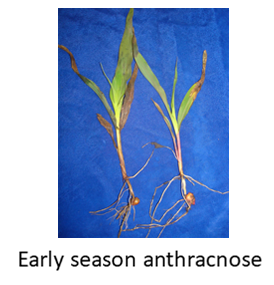
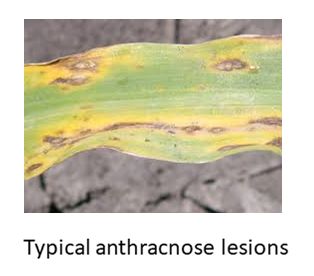
Mid-season anthracnose typically, is related to crop stress after pollination. If conditions are conducive for further development the later phase causes stalk rot. Anthracnose stalk rot is the most common of the stalk rots.
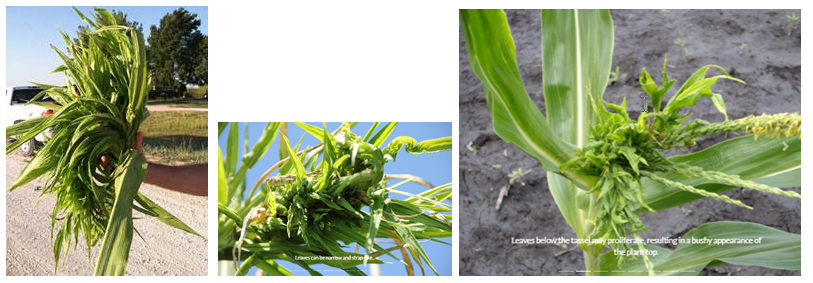
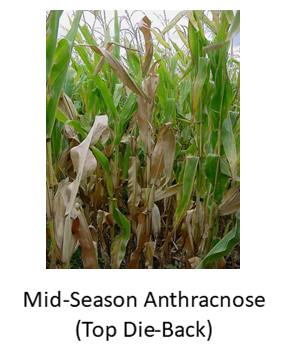
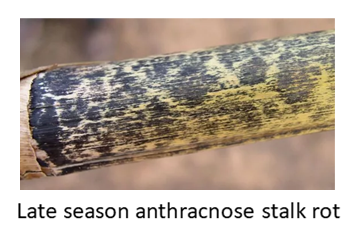
Methods to manage anthracnose:
- Crop rotation for at least one year
- Bury corn residue to hasten the breakdown of the fungal pathogen
- Genetic selection, there are differences between hybrids
- Consider a fungicide application from V5 through tassel growth stage
Crazy Top
Is there a more fitting disease to fit the character of 2020?! Across the Midwest, this year has brought a higher rate than normal of “Crazy Top” in corn. We typically see a little bit of this every year, but it is pretty rare. Usually we just see a plant or two in an entire field, so we shrug our shoulders and move on. We might even think it looks cool! But from Indiana to Wisconsin to the Dakotas, there is a spike in crazy top cases this year.,
Because of its random and rare nature, we tend not to think about the cause of such an abnormality. Crazy Top is actually a deformation of the meristems (the growing points) caused by a pathogen (Sclerophthora macrospora) that infects the plants early in the season. The risk of infection is increased by wet conditions early in the growing season (May/June). Infected plants are usually stunted, but most cases this year still have full size plants. Plants will sometimes have deformed tassels which may grow a cluster of leaves of try to grow and ear. Ear shoots may have an excess number of leaves stacked in place of the husks. “Severe” cases are so rare that it is a difficult thing to characterize by product: so, we don’t really know if any one product is more or less susceptible. Environmental conditions dominate in these cases.
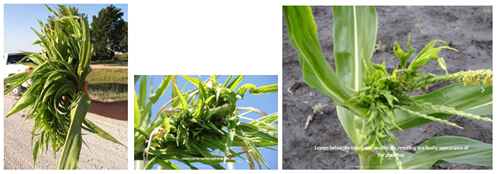
Photos from cropprotectionnetwork.org.
Corteva Technology Use Agreements
All growers with orders for any Corteva Agriscience brand seed product, regardless of crop or trait (including non-GM products) need to have a signed Corteva Technology Use Agreement in place by September 1. Growers should sign the Corteva Technology Use Agreement electronically at www.agcelerate.com. Signing electronically is preferable, however, paper copies are available at www.traitstewardship.com.
 |
 |
 |
 |
 |
| Brian Weller Western Region 507.456.3034 |
Dan Ritter Central Region 219.863.0583 |
Branden Furseth Northern Region 608.513.4265 |
Rod King Eastern Region 574.596.6721 |
Terry Jones Eastern Region 419.630.3115 |
